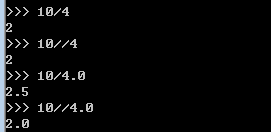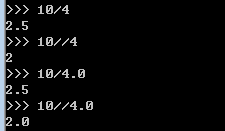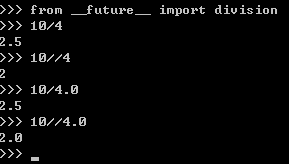python中数字类型与处理工具
python中的数字类型工具
python中为更高级的工作提供很多高级数字编程支持和对象,其中数字类型的完整工具包括:
1.整数与浮点型,
2.复数,
3.固定精度十进制数,
4.有理分数,
5.集合,
6.布尔类型
7.无穷的整数精度
8.各种数字内置函数及模块。
基本数字类型
python中提供了两种基本类型:整数(正整数金额负整数)和浮点数(注:带有小数部分的数字),其中python中我们可以使用多种进制的整数。并且整数可以用有无穷精度。
整数的表现形式以十进制数字字符串写法出现,浮点数带一个小数点或者使用科学计数法e来表示。在python2版本中,整数还分为一般整数(32位)和长整数(无穷精度),长整数以l结尾。带了python3中整数就只有一种形式了,具有无尽精度。
当然,在Python中整数还有二进制(0bxxxxxxxx),八进制(0oxxxxxxxx),和十六进制(0x xxxxxxxx)的形式出现。
十进制数与其他进制的转换:
s=16 print(bin(s)) print(oct(s)) print(hex(s)) 运行结果: 0b10000 0o20 0x10
print('{0:o},{1:x},{2:b}'.format(16,16,16)) print('%o,%x,%X'%(16,16,16)) 运行结果: 20,10,10000 20,10,10
其他进制转化为十进制:
a=int('0b10000',2) b=int('0o20',8) c=int('0x10',16) print(a) print(b) print(c) 运行结果: 16 16 16
print(eval('16')) print(eval('0b10000')) print(eval('0o20')) print(eval('0x10')) 运行结果: 16 16 16 16
python表达式操作符
表达式是数学符号和操作符号写出来的,下表为python表达式操作符与程序:
| 操作符 | 描叙 |
| yield | 生成 器函数发送协议 |
| lambda args:expression | 生成匿名函数 |
| x if y else z | 三元表达式 |
| x or y | 逻辑或(存在短路算法) |
| x and y | 逻辑与(存在短路算法) |
| not x | 逻辑非 |
| x in y , x not in y | 成员关系 |
| x is y ,x is not y | 对象实体測试 |
| x<y,x<=y,x>y,x>=y,x==y,x!=y | 比較大小 |
| x|y | 位或,集合并集 |
| x^y | 位异或,集合对称差 |
| x&y | 位与,集合交集 |
| x<<y,x>>y | 左移或者右移y位 |
| x+y,x-y | 加减法、合并删除 |
| x*y,x%y,x/y,x//y | 乘,取余数,除,地板除 |
| -x,+x | 一元减法 |
| ~x | 按位求补(取反) |
| x**y | 幂运算 |
| x[i] | 索引,函数调用 |
| x[i:j:k] | 分片 |
| x(...) | 调用函数 |
| x.attr | 调用属性 |
| (...) | 元组,表达式,生成器 |
| [...] | 列表,列表解析 |
| {...} | 字典,集合,集合和字典解析 |
注:操作符在python2和python3中略有不同,python2中不等于用!=或》<>来表示,在python3中<>方法被取消,不等于就用!=来表示。
x<y<z等同于x<y and y<z,
在python2中可以使用混合类型,在python3中比较混合类型大小是会报错的,
python2
a = 1 > 'a' print a 运行结果: False
python3
a=1 > 'a' print(a) 运行结果: Traceback (most recent call last): File "C:/Users/jeff/PycharmProjects/python_file/practice/prac2.py", line 92, in <module> a=1 > 'a' TypeError: unorderable types: int() > str()
上面的表格也是程序运行的优先级表格,自上而下,优先级越来越高,当然如果想要改变优先级,要是用括号来做。括号在python数字操作中经常会使用到,他不仅强制程序按照你想要的顺序运行,同时也增加了程序的可读性。

class int(object): """ int(x=0) -> int or long int(x, base=10) -> int or long Convert a number or string to an integer, or return 0 if no arguments are given. If x is floating point, the conversion truncates towards zero. If x is outside the integer range, the function returns a long instead. If x is not a number or if base is given, then x must be a string or Unicode object representing an integer literal in the given base. The literal can be preceded by '+' or '-' and be surrounded by whitespace. The base defaults to 10. Valid bases are 0 and 2-36. Base 0 means to interpret the base from the string as an integer literal. >>> int('0b100', base=0) 4 """ def bit_length(self): """ 返回表示该数字的时占用的最少位数 """ """ int.bit_length() -> int Number of bits necessary to represent self in binary. >>> bin(37) '0b100101' >>> (37).bit_length() 6 """ return 0 def conjugate(self, *args, **kwargs): # real signature unknown """ 返回该复数的共轭复数 """ """ Returns self, the complex conjugate of any int. """ pass def __abs__(self): """ 返回绝对值 """ """ x.__abs__() <==> abs(x) """ pass def __add__(self, y): """ x.__add__(y) <==> x+y """ pass def __and__(self, y): """ x.__and__(y) <==> x&y """ pass def __cmp__(self, y): """ 比较两个数大小 """ """ x.__cmp__(y) <==> cmp(x,y) """ pass def __coerce__(self, y): """ 强制生成一个元组 """ """ x.__coerce__(y) <==> coerce(x, y) """ pass def __divmod__(self, y): """ 相除,得到商和余数组成的元组 """ """ x.__divmod__(y) <==> divmod(x, y) """ pass def __div__(self, y): """ x.__div__(y) <==> x/y """ pass def __float__(self): """ 转换为浮点类型 """ """ x.__float__() <==> float(x) """ pass def __floordiv__(self, y): """ x.__floordiv__(y) <==> x//y """ pass def __format__(self, *args, **kwargs): # real signature unknown pass def __getattribute__(self, name): """ x.__getattribute__('name') <==> x.name """ pass def __getnewargs__(self, *args, **kwargs): # real signature unknown """ 内部调用 __new__方法或创建对象时传入参数使用 """ pass def __hash__(self): """如果对象object为哈希表类型,返回对象object的哈希值。哈希值为整数。在字典查找中,哈希值用于快速比较字典的键。两个数值如果相等,则哈希值也相等。""" """ x.__hash__() <==> hash(x) """ pass def __hex__(self): """ 返回当前数的 十六进制 表示 """ """ x.__hex__() <==> hex(x) """ pass def __index__(self): """ 用于切片,数字无意义 """ """ x[y:z] <==> x[y.__index__():z.__index__()] """ pass def __init__(self, x, base=10): # known special case of int.__init__ """ 构造方法,执行 x = 123 或 x = int(10) 时,自动调用,暂时忽略 """ """ int(x=0) -> int or long int(x, base=10) -> int or long Convert a number or string to an integer, or return 0 if no arguments are given. If x is floating point, the conversion truncates towards zero. If x is outside the integer range, the function returns a long instead. If x is not a number or if base is given, then x must be a string or Unicode object representing an integer literal in the given base. The literal can be preceded by '+' or '-' and be surrounded by whitespace. The base defaults to 10. Valid bases are 0 and 2-36. Base 0 means to interpret the base from the string as an integer literal. >>> int('0b100', base=0) 4 # (copied from class doc) """ pass def __int__(self): """ 转换为整数 """ """ x.__int__() <==> int(x) """ pass def __invert__(self): """ x.__invert__() <==> ~x """ pass def __long__(self): """ 转换为长整数 """ """ x.__long__() <==> long(x) """ pass def __lshift__(self, y): """ x.__lshift__(y) <==> x<<y """ pass def __mod__(self, y): """ x.__mod__(y) <==> x%y """ pass def __mul__(self, y): """ x.__mul__(y) <==> x*y """ pass def __neg__(self): """ x.__neg__() <==> -x """ pass @staticmethod # known case of __new__ def __new__(S, *more): """ T.__new__(S, ...) -> a new object with type S, a subtype of T """ pass def __nonzero__(self): """ x.__nonzero__() <==> x != 0 """ pass def __oct__(self): """ 返回改值的 八进制 表示 """ """ x.__oct__() <==> oct(x) """ pass def __or__(self, y): """ x.__or__(y) <==> x|y """ pass def __pos__(self): """ x.__pos__() <==> +x """ pass def __pow__(self, y, z=None): """ 幂,次方 """ """ x.__pow__(y[, z]) <==> pow(x, y[, z]) """ pass def __radd__(self, y): """ x.__radd__(y) <==> y+x """ pass def __rand__(self, y): """ x.__rand__(y) <==> y&x """ pass def __rdivmod__(self, y): """ x.__rdivmod__(y) <==> divmod(y, x) """ pass def __rdiv__(self, y): """ x.__rdiv__(y) <==> y/x """ pass def __repr__(self): """转化为解释器可读取的形式 """ """ x.__repr__() <==> repr(x) """ pass def __str__(self): """转换为人阅读的形式,如果没有适于人阅读的解释形式的话,则返回解释器课阅读的形式""" """ x.__str__() <==> str(x) """ pass def __rfloordiv__(self, y): """ x.__rfloordiv__(y) <==> y//x """ pass def __rlshift__(self, y): """ x.__rlshift__(y) <==> y<<x """ pass def __rmod__(self, y): """ x.__rmod__(y) <==> y%x """ pass def __rmul__(self, y): """ x.__rmul__(y) <==> y*x """ pass def __ror__(self, y): """ x.__ror__(y) <==> y|x """ pass def __rpow__(self, x, z=None): """ y.__rpow__(x[, z]) <==> pow(x, y[, z]) """ pass def __rrshift__(self, y): """ x.__rrshift__(y) <==> y>>x """ pass def __rshift__(self, y): """ x.__rshift__(y) <==> x>>y """ pass def __rsub__(self, y): """ x.__rsub__(y) <==> y-x """ pass def __rtruediv__(self, y): """ x.__rtruediv__(y) <==> y/x """ pass def __rxor__(self, y): """ x.__rxor__(y) <==> y^x """ pass def __sub__(self, y): """ x.__sub__(y) <==> x-y """ pass def __truediv__(self, y): """ x.__truediv__(y) <==> x/y """ pass def __trunc__(self, *args, **kwargs): """ 返回数值被截取为整形的值,在整形中无意义 """ pass def __xor__(self, y): """ x.__xor__(y) <==> x^y """ pass denominator = property(lambda self: object(), lambda self, v: None, lambda self: None) # default """ 分母 = 1 """ """the denominator of a rational number in lowest terms""" imag = property(lambda self: object(), lambda self, v: None, lambda self: None) # default """ 虚数,无意义 """ """the imaginary part of a complex number""" numerator = property(lambda self: object(), lambda self, v: None, lambda self: None) # default """ 分子 = 数字大小 """ """the numerator of a rational number in lowest terms""" real = property(lambda self: object(), lambda self, v: None, lambda self: None) # default """ 实属,无意义 """ """the real part of a complex number"""
混合类型
这里指的是混合数字类型,比如整数和浮点数相加的结果是什么呢?
其实在python中首先将备操作对象转换成其中最复杂的操作对象的类型,然后再进行相同类型的对象进行数学运算。
print(1+0.2) 运行结果: 1.2
注:除此之外,在python中还存在着运算符重载功能比如‘+’,除了做数字加法运算,在字符串拼接时也适用‘+’。
数字显示格式
由于一些硬件限制,数字显示有时看起来会很奇怪,例如:
在命令行中操作 >>>num = 1 / 3.0 >>>num 0.333333333333333333331 在pycharm中print操作 num = 1/3.0 print(num) 运行结果: 0.3333333333333333
num = 1/3.0
print('{0:4.2f}'.format(num))#4是前面空格格数,2是保留小数位
运行结果:
0.33
在命令行中显示的形式叫做默认的交互式回显,而print打印的叫做友好式回显,与reper和str的显示是一致的:
>>>num = 1/3.0 >>>repr(num) 0.333333333333333333331
>>>str(num)
0.3333333333333333
除法:传统除法,floor除法,真除法和截断除法
除法是python2与python3之间非常重要的一个变化。
一、除法操作符
python有两种除法操作符‘x/y’与‘x//y’,其中‘/’在python2中是传统除法,即省略浮点数小数部分,然而显示整数,在python3中,除法就是真除法,即无论什么类型都会保留小数部分;‘//’也叫作floor除法,在python3中省略小数部分,剩下最小的能整除的整数部分,操作数如果是浮点数则结果显示浮点数,python2中整数截取整数,浮点数执行保留浮点数。
例:在python2中:

在python3中:

在python2中若是想要使用python3中的'/'则需要调用模块来完成,在python2中调用division模块:

截断除法与floor除法一样都是取最接近整数向下取整,这使得在负数时也生效,即-2.5则为-3,而不是-2,想要得到真正的截取需要调用math模块:

python还支持复数的计算:
 还支持compliex(real,imag)来创建复数。
还支持compliex(real,imag)来创建复数。
更多复数计算参考模块cmath的参考手册。
位操作
x=1 print(x<<2) print(x|2) print(x&2) print(x^2) 运行结果: 4 3 0 3
python3中使用bit_length查看二进制位数:
x=99 print(bin(x)) print(x.bit_length()) print(len(bin(x))-2) 运行结果: 0b1100011 7 7
内置数学工具
math模块
import math print(math.pi) print(math.e) print(math.sin(110)) print(math.sqrt(144)) print(pow(2,3)) print(abs(-50)) print(sum((1,2,3))) print(max(1,2,3)) print(min(1,2,3)) 运行结果: 3.141592653589793 2.718281828459045 -0.044242678085070965 12.0 8 50 6 3 1
对于截取浮点数的操作有四种方式:
print(math.floor(2.577)) print(math.trunc(2.577)) print(round(2.577)) print(int(2.577)) 运行结果: 2 2 3 2
random模块
获取随机数
import random print(random.random()) print(random.randint(1,100)) 运行结果: 0.9534845221467178 79
其他数字类型介绍
除了常见的整型与浮点数,还有一些其他较为常见的数字类型。
一、小数数字
虽然学习python有一段时间了,但是确实没有太明白浮点数与小数的区别,其实小数在某种程度上就是浮点数,只不过他有固定的位数和小数点,在python中有专门的模块导入小数,from decimal import Decimal。
注:浮点数缺乏精确性。
print(0.1+0.1+0.1-0.3) 输出结果: 5.551115123125783e-17
我想看到这里的兄弟可能已经慌了,然后使用python解释器试了一下,果然结果就是5.551115123125783e-17虽然很接近0,但是不是0。所以说浮点型本质是缺乏精确性。要精确就需要调用from decimal import Decimal。
from decimal import Decimal print(Decimal('0.1')+Decimal('0.10')+Decimal('0.10')-Decimal('0.30')) 运行结果: 0.00
可以看出来小数相加也是自动升级为位数最多的。
注:浮点数创建小数对象,由于浮点数本身可能就不精确所以转换会产生较多的位数。
from decimal import Decimal print(Decimal.from_float(1.88)) print(Decimal.from_float(1.25)) 输出结果: 1.87999999999999989341858963598497211933135986328125 1.25
这里只是简单介绍一下小数,更多关于小数在以后看过Python标准库手册后再来总结。
二、分数
分数类型与小数极为相似,他们都是通过固定小数位数和指定舍入或截取策略控制精度。分数使用Fraction模块导入。
from fractions import Fraction x=Fraction(1,3) y=Fraction(2,3) print(x+y) 输出结果: 1
注:对于内存给定有限位数无法精确表示的值,浮点数的局限尤为明显。分数和小数都比浮点数更为准确。
三、集合
集合是无序元素组成,打印时顺序也是无序的,但是集合中没有重复的元素,所以我们常使用集合去重,尤其是在涉及数字和数据库的工作中。
我们有两个集合a与b:
a与b的交集为a.intersection(b)或者a & b。
a与b的差集为a.difference(b)或者a-b。
a与b的并集为a.union(b)或者a|b。
反向差集与对称差集(并集减去交集)为a.symmetric_difference(b)或者a^b。
合并为a.update(b),a.difference_update(b)求差集并赋值给a集合
删除元素可用discard(元素)或者remove(元素),pop()是随机删除一个元素,add插入一个项目。
注:set是可变数据类型,但是set里面的元素一定是不可变数据类型。
x={'a','c','b'}
y={'a','g','b'}
z={'a'}
print('a' in x)
print(x-y)
print(x|y)
print(x&y)
print(x^y)
print(z<y)
x={'a','c','b'}
y={'a','g','b'}
z={'a'}
print(x.intersection(y))
print(x.union(y))
x.add('s')
print(x)
print(x.pop())
x.update({'w','e','o'})
print(x)
print(x)
运行结果:
{'a', 'b'}
{'c', 'a', 'b', 'g'}
{'a', 'b', 'c', 's'}
a
{'o', 'c', 's', 'w', 'b', 'e'}
{'o', 'c', 's', 'w', 'b', 'e'}
注:在python中{}是空字典,如果想要定义空集合要用set()。
集合要是添加列表等可变类型则会报错。
x={'a','c','b'}
l=[1,2,3]
x.add(l)
print(x)
运行结果:
Traceback (most recent call last):
File "C:/Users/jeff/PycharmProjects/python_file/practice/prac2.py", line 111, in <module>
print(x.add(l))
TypeError: unhashable type: 'list'
正确的添加序列方式为添加元组。
x={'a','c','b'}
l=(1,2,3)
x.add(l)
print(x)
运行结果:
{'c', 'b', 'a', (1, 2, 3)}
定义不可操作的集合使用frozenset定义集合。
字典解析:
与列表解析相类似,集合也是可迭代对象,所以可以使用for循环遍历。
x={1,2,3}
print({i ** 2 for i in x})
运行结果:
{1, 9, 4}
四、布尔值
python的一个数据类型,有两个值Ture 与 False。
print(type(True)) print(True == 1) print(True is 1) print(True + 1) 运行结果: <class 'bool'> True False 2
集合和bool值,还是比较常见的类型,在基础学习里也有涉及,在这里就不多写了。
python中的数字在程序编写时广泛使用,今后还会更深层次的学习python的扩展库。


